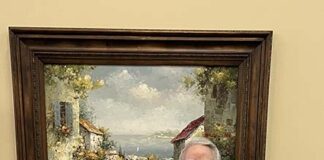
Last spring was a discouraging time for Billy Mickle. He was diagnosed with liver cancer and his course of treatment seemed unsure.
Then he was referred to Nelson Royall, M.D., a Tulsa-based OU Physicians surgeon who was the first to bring major robotic liver surgery to Oklahoma. Royall used the robot to perform minimally invasive surgery on Mickle, removing the left lobe of his liver, in which the cancer was confined, and sent him home only three days later.
For Mickle, who lives in Sand Springs, Royall’s expertise was a godsend. The cancer had not spread, his small incisions healed quickly, and he’s back to his daily life.
“Dr. Royall and his staff are just amazing,” Mickle said. “I give him the highest praise.”
Royall brings a unique service to Oklahoma. He is one of only a handful of robotic liver and pancreas surgeons in the United States and is the first in Oklahoma to use the robot to perform surgery for liver and pancreatic cancer. He is fellowship-trained in surgery of the liver, bile duct and pancreas, bringing years of surgical oncology experience to patients in Oklahoma and around the region.
With robotic liver surgery, patients bleed less, meaning they don’t require blood products or transfusions, Royall said. They face a lower risk for complications, leave the hospital faster, and recover more quickly than those who undergo traditional open surgeries. Incisions are five to eight millimeters, which leads to less pain and scarring. In addition, the robot makes surgery possible for many patients who couldn’t tolerate open surgery or aren’t candidates for laparoscopic surgery because of other issues.
Patients also enjoy a good prognosis after robotic liver surgery because of Royall’s skills in performing more precise and advanced maneuvers than would be possible with laparoscopic surgery.
“The robot allows me to have 360-degree range of motion, which lets me get around difficult areas and structures,” he said. “I can perform more delicate suturing, and I can do complex movements without any difficulty. We also remove lymph nodes from the area to make sure the cancer hasn’t spread, and the robot allows me to remove them safely while protecting sensitive blood vessels and organs in the area.”
The robotic system provides additional tools to enhance the safety of the surgery. Three-dimensional imaging allows Royall to see where structures are in space. The robot also offers what is equivalent to X-ray vision – allowing him to see inside the liver and bile duct system.
“It allows me to quickly find the bile duct and blood vessels feeding the different parts of the liver,” he said. “I can make sure the ones that need to be protected are not injured during the surgery. It also helps to prevent leaks from areas like the bile duct.”
Royall finds it gratifying to provide a safer surgery that results in outcomes at least as good or better than traditional and laparoscopic surgery. His patients are grateful to have the option in Oklahoma.
“I was very blessed to have this surgery,” Mickle said. “I knew I was going to be alright.”













